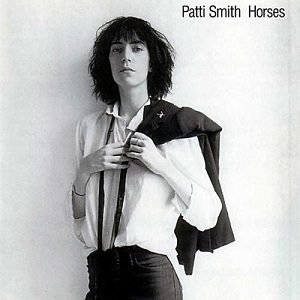Released in 1975, Horses marked the seismic arrival of Patti Smith as a force in rock music—a bold fusion of punk attitude, poetic lyricism, and a raw, unvarnished sound that would influence generations to come. As her debut studio album, Horses not only established Smith’s reputation as the “punk poet laureate” but also laid the groundwork for the emerging punk rock movement in New York City, alongside acts like Television and the Ramones.
While Smith was already known in underground circles for her electrifying poetry readings and performances at iconic venues like CBGB, Horses elevated her from avant-garde poet to revolutionary rock figure. Produced by John Cale of The Velvet Underground, the album retained the visceral, confrontational energy of Smith’s live shows while infusing it with a stark, minimalist soundscape that complemented her piercing lyrics.
In crafting Horses, Smith aimed to shatter the boundaries between rock music and poetry. She famously described the album as an attempt to merge Rimbaud with rock ‘n’ roll, creating a transcendent experience that could both challenge and inspire listeners. From its arresting opening line, “Jesus died for somebody’s sins but not mine,” to its sprawling, improvisational passages, Horses embodies Smith’s vision of art as a vehicle for liberation and self-expression.
Sonic Exploration

Production Quality
The production of Horses, helmed by John Cale, strikes a balance between raw immediacy and structured chaos. While not entirely lo-fi, the album avoids the glossy, overproduced aesthetics of mid-’70s rock in favor of a more unvarnished, organic sound. Cale, known for his work with The Velvet Underground, embraced an approach that preserved the unpredictable energy of Smith’s performances, making the album feel urgent and alive. The mix allows space for each instrument to breathe, with Smith’s voice often towering over the arrangements like a preacher delivering an apocalyptic sermon. At times, the production feels almost confrontational—deliberately imperfect, rough around the edges, yet meticulously crafted to amplify the album’s defiant spirit.
Musical Arrangements
Instrumentally, Horses moves between stripped-down, spoken-word-driven pieces and explosive, full-band freakouts. Lenny Kaye’s guitar work is particularly noteworthy—oscillating between jagged punk riffs and fluid, psychedelic textures. Tracks like “Gloria” build tension through sparse, pulsating bass lines before erupting into anthemic, electric catharsis. Meanwhile, “Birdland” and “Land” stretch the limits of rock structure, embracing free-form improvisation, with Smith’s vocals drifting between whispers and wails.
Unlike many punk albums that followed, Horses doesn’t adhere to a rigid, three-chord attack. Instead, it takes a more dynamic, almost literary approach, shifting moods and textures within songs. Ivan Král’s bass lines and Jay Dee Daugherty’s drumming provide a steady foundation, while Richard Sohl’s piano work adds an unexpected elegance, particularly on tracks like “Break It Up.” The arrangements serve as an open canvas for Smith’s lyrical storytelling, allowing her words to dictate the musical flow rather than the other way around.
Genre Elements
Though often categorized as proto-punk, Horses resists easy classification. It blends elements of garage rock, art rock, and spoken-word poetry with an undercurrent of jazz-like spontaneity. Tracks like “Free Money” have a driving rock energy that hints at the punk explosion to come, while others, like “Birdland,” border on avant-garde, eschewing conventional song structures in favor of stream-of-consciousness storytelling. The album’s sonic fluidity makes it feel like both a culmination of rock’s past—drawing from early rock ‘n’ roll, beat poetry, and the blues—and a prophecy of its future, paving the way for the punk and alternative movements.
Lyrical Analysis

Themes and Messages
At its core, Horses is an album about transcendence—transcending societal expectations, personal limitations, and even the boundaries of life and death. Patti Smith weaves themes of rebellion, sexual liberation, artistic expression, and existential yearning into a poetic and often surreal narrative. The album brims with religious and mythological imagery, exploring themes of salvation and destruction in equal measure.
One of the most striking themes is defiance against authority and conventional morality, introduced immediately in Horses‘ opening lines: “Jesus died for somebody’s sins but not mine.” This reimagining of Van Morrison’s “Gloria” becomes a declaration of autonomy, rejecting imposed guilt in favor of self-determination. Similarly, “Break It Up” mythologizes rock and roll itself, portraying the tragic death of Jim Morrison as a metaphor for artistic resurrection.
Throughout the album, freedom—both physical and spiritual—is a recurring motif. In “Free Money,” Smith dreams of economic escape, channeling working-class desperation into an ecstatic vision of possibility. “Land” (subtitled “Horses/Land of a Thousand Dances/La Mer”) is an abstract fever dream of transformation, sexual awakening, and violent catharsis, following a character named Johnny through a surreal, fragmented narrative. This fusion of raw, bodily experience with transcendental themes defines Horses, giving it a prophetic, almost ritualistic feel.
Lyrical Depth
Smith’s lyrics are nothing short of literary, drawing from the influences of Beat poets like Allen Ginsberg, the surrealist visions of Arthur Rimbaud, and the fiery political urgency of Bob Dylan. She doesn’t just write lyrics—she crafts poetic monologues that blur the line between song and spoken-word performance.
Many tracks lack traditional verse-chorus structures, instead unfolding like epic poems or stream-of-consciousness revelations. “Birdland” is a perfect example, inspired by Peter Reich’s book A Book of Dreams, in which a young boy copes with the loss of his father by envisioning his ascension into the sky. Smith turns this concept into a sprawling, hallucinatory odyssey, where reality dissolves into a dreamscape of flying saucers and existential wonder.
While some songs, like “Kimberly” (a reflection on her younger sister’s birth) or “Redondo Beach” (a reggae-inflected track that cryptically hints at heartbreak and possibly suicide), are more grounded in tangible experiences, they still carry an enigmatic quality, inviting multiple interpretations. Smith’s ability to shift between raw storytelling and abstract, symbolic lyricism is what makes Horses such a compelling listen.
Emotional Impact
The lyrics of Horses hit with an emotional force that is both deeply personal and universally resonant. Smith’s words don’t just describe emotions—they embody them. Her delivery oscillates between whispers and howls, making every line feel like an incantation, a plea, or a battle cry.
There is a deep sense of longing and restlessness throughout the album, whether it’s the yearning for escape in “Free Money” or the violent, ecstatic visions of “Land.” At the same time, moments of tenderness and nostalgia, such as in “Kimberly,” add depth to the album’s emotional range.
Cohesion and Flow

Track Progression
Horses unfolds like a fever dream—each track feeding into the next, not always in a traditional narrative sense, but through an evolving emotional and sonic journey. The album opens with an immediate jolt: “Gloria” sets the tone with its defiant spoken-word intro, which then erupts into a primal, electrifying rock explosion. This establishes Horses as both a confrontation and an invitation—Smith calling the listener into her world of poetic rebellion.
From there, the album ebbs and flows between structured songs and sprawling, near-improvisational pieces. “Redondo Beach” offers a stark contrast to the intensity of “Gloria,” with its reggae-infused groove and melancholic storytelling, before “Birdland” plunges into a surrealist odyssey of grief and transformation. This sequencing keeps the listener on edge, never quite settling into predictability. The second half of the album builds to an almost cinematic climax, with “Land” acting as a vortex of raw energy and abstraction before “Elegie” closes the record with a solemn, mournful farewell, serving as both an elegy for fallen rock icons (specifically Jimi Hendrix) and a moment of reflection after the storm.
The transitions between songs are not seamless in the conventional sense; rather, they feel like jolts of consciousness—one moment in a dream, the next in stark reality. This unpredictability adds to the album’s visceral impact, making each track feel like a distinct yet interconnected chapter in Smith’s vision.
Thematic Consistency
Despite its shifts in musical style and structure, Horses maintains a striking thematic and emotional consistency. The entire album feels like a manifesto of artistic and personal freedom, united by Smith’s poetic intensity and defiant spirit. Whether she’s channeling rage, sorrow, or transcendence, every song reinforces the album’s overarching themes of liberation, transformation, and raw expression.
Sonically, Horses also manages to stay cohesive despite its genre-blurring tendencies. The raw, minimal production keeps everything grounded, while the band’s performances—particularly Lenny Kaye’s chameleonic guitar work—adapt to the mood of each song without feeling disjointed. Even when the album veers from punk rock to reggae influences or jazz-like improvisation, it never feels forced or out of place. Instead, these shifts serve the album’s broader mission: breaking down artistic barriers and forging something entirely new.
Standout Tracks and Moments
Highlight Key Tracks
While Horses functions as a unified artistic statement, certain tracks stand out as defining moments in both Patti Smith’s career and rock history.
- “Gloria” – The album’s opening track is one of the most iconic reimaginings in rock. Smith transforms the Them classic into a personal declaration of defiance, kicking off with the immortal line, “Jesus died for somebody’s sins but not mine.” Her slow, deliberate spoken delivery builds tension before the band crashes in, turning a garage rock staple into a fiery, punk-gospel revival.
- “Birdland” – Perhaps the album’s most experimental track, “Birdland” is a free-form jazz-poetry explosion. Inspired by Peter Reich’s A Book of Dreams, Smith delivers an unhinged, stream-of-consciousness performance over a shifting musical backdrop. The song showcases her ability to turn a song into a living, breathing entity—chaotic, tender, and transcendent all at once.
- “Land” (Horses/Land of a Thousand Dances/La Mer) – A sprawling, nine-minute epic that encapsulates everything Horses represents. It weaves together a fragmented narrative about a boy named Johnny, violence, sexual awakening, and rock & roll mythology, all set to a pulsating, hypnotic rhythm. The song builds in intensity, incorporating the melody of Wilson Pickett’s “Land of a Thousand Dances,” before descending into pure, frenzied catharsis.
- “Elegie” – In stark contrast to the album’s wildest moments, “Elegie” serves as its somber farewell. Stripped down to just Smith’s vocals and a delicate guitar, the song was written in tribute to Jimi Hendrix and, by extension, to all lost artists. It’s a hauntingly intimate moment, closing the record on a reflective note.
Memorable Moments
- The Opening of “Gloria” – The way Smith delivers that first line—half-spoken, half-spelled-out, dripping with both conviction and provocation—immediately sets the tone for the entire album. It’s one of the most unforgettable introductions in rock history.
- The Climax of “Land” – As Smith repeatedly chants “Go Rimbaud! Go Johnny go!”, the song spirals into an all-consuming whirlwind of noise and poetry. It’s the sound of music and language colliding with pure, physical energy—a moment of unfiltered, artistic liberation.
- The Spoken-Word Sections in “Birdland” – Throughout the track, Smith’s voice moves from delicate whispers to frenzied shouts, as if she’s channeling the spirits of poets and rockstars all at once. Her delivery makes the song feel almost possessed, an unpredictable force of nature.
- The Final Notes of “Elegie” – The way the album ends—softly, with a lingering sense of loss—feels like an exhale after an emotional whirlwind. It’s an unexpected but deeply poignant conclusion, reinforcing the album’s themes of mortality and artistic legacy.
Artistic Contribution and Innovation

Place in Genre/Industry
Horses wasn’t just an album—it was a catalyst. Released in 1975, it arrived at a crucial moment in rock history, bridging the gap between the poetic sensibilities of the Beat generation and the snarling, rebellious energy of punk. While proto-punk acts like The Stooges, The Velvet Underground, and the New York Dolls had already begun dismantling rock’s excesses, Horses introduced a more literary, free-form approach to the movement.
Patti Smith’s fusion of rock and poetry made her one of the first true punk intellectuals, paving the way for artists who saw music as more than just entertainment—it was a means of radical self-expression. Her influence is felt across punk, post-punk, alternative rock, and beyond, inspiring artists from R.E.M. and U2 to PJ Harvey and Sonic Youth. Unlike many punk records that would follow, Horses wasn’t about three-chord simplicity; it was about possibility—what rock music could be when stripped of formula and convention.
In the larger music industry, Horses was also groundbreaking as a debut from a female artist who refused to conform. Smith’s androgynous presence on the album cover (a stark, Robert Mapplethorpe photograph that remains one of the most iconic in rock history) challenged traditional gender norms, offering a rebellious alternative to the polished female rock stars of the time. In many ways, Horses expanded the idea of who could front a rock band, making space for women in punk and alternative music who didn’t fit the industry mold.
Innovation
From its production choices to its approach to genre, Horses was unlike anything else at the time.
- The Blurring of Poetry and Rock – While spoken-word elements had appeared in rock before, Smith took the concept further by making it the foundation of her songwriting. Tracks like “Birdland” and “Land” unfold as sprawling, near-improvised poetic monologues, with the music serving as a fluid, responsive backdrop rather than a rigid structure. This approach directly influenced later artists in punk, post-punk, and even hip-hop, where spoken-word delivery became a tool for raw, emotive storytelling.
- Raw, Unfiltered Production – John Cale’s production kept the record intentionally rough around the edges, preserving the live energy of Smith’s performances. This emphasis on authenticity over polish foreshadowed the aesthetic choices of punk and indie rock in the decades that followed.
- Genre Fluidity – Horses is often labeled a punk album, but it refuses to be confined to a single style. It borrows elements from garage rock, jazz, reggae, and spoken-word performance, creating a hybrid that was both ahead of its time and entirely timeless. This genre-fluidity helped set the stage for alternative and indie rock’s ethos of experimentation.
- A New Archetype for Female Rock Artists – Patti Smith’s presence in the rock world was revolutionary. She wasn’t styled for mass appeal, nor was she performing femininity in a way the industry expected. She was raw, intellectual, androgynous, and aggressive—a presence that defied the conventions of what a “female rock star” was supposed to be. In doing so, she inspired generations of women in music to embrace their own artistic identities without compromise.
Closing Thoughts

Nearly five decades after its release, Horses remains one of the most vital and uncompromising statements in rock history. It is an album that doesn’t just challenge the listener—it demands engagement. From its fearless lyricism to its raw, unfiltered sound, Patti Smith’s debut is a masterclass in artistic risk-taking, one that shattered genre conventions and opened doors for generations of musicians and poets alike.
Strengths
- Unparalleled lyricism – Smith’s poetic, visionary writing elevates Horses beyond traditional rock songwriting, making it an immersive, literary experience.
- Raw, electrifying energy – The album captures the spirit of punk before punk fully arrived, blending rebellion with artistic sophistication.
- Fearless innovation – Whether through its spoken-word passages, genre-blurring compositions, or unpolished production, Horses defied every norm of the mid-’70s rock landscape.
- Cultural and historical significance – The album not only influenced the punk movement but also set a new standard for what rock music could achieve intellectually and emotionally.
- Emotional depth – From the chaotic catharsis of “Land” to the mournful quiet of “Elegie,” Horses offers a full spectrum of human experience, making it an album that resonates deeply on multiple levels.
Weaknesses
For those expecting a more structured or melodic experience, Horses can be a challenging listen. The free-form, stream-of-consciousness nature of tracks like “Birdland” and “Land” might feel disorienting to some. However, these very qualities are what make the album so unique and groundbreaking. Its rawness, its unpredictability, and its refusal to conform are not flaws—they are its purpose.
Official Rating
Horses is more than just an album—it’s a revolution captured on tape. It’s the sound of an artist becoming in real time, of someone breaking down walls and inviting the rest of the world to do the same. It remains a beacon for outsiders, dreamers, and those who refuse to be boxed in by society’s expectations.
For its innovation, its poetic depth, and its undeniable impact, Horses deserves nothing less than a 10/10. It is not just a masterpiece of punk or rock, but a masterpiece of expression—a record that continues to inspire, challenge, and liberate with every listen.
